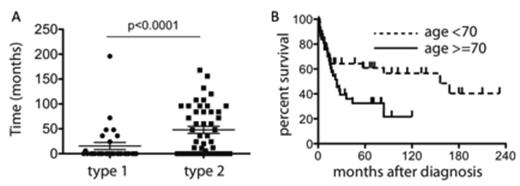Abstract

The classical Hodgkin lymphoma variant of Richter transformation (CHL-RT) occurs rarely in patients with chronic lymphocytic leukemia/small lymphocytic lymphoma (CLL). Two morphological patterns have been described: type I with Hodgkin/Reed-Sternberg (HRS) cells scattered in a CLL background, and type II with typical CHL morphology. HRS cells are frequently positive for EBV and can be clonally related or unrelated to CLL. The clinical significance of the different morphological patterns is unclear. What factors dictate the cellular derivation of the HRS cells remains elusive.
We retrospectively reviewed 77 cases of CHL-RT submitted to our consultation service. Clinicopathological characteristics were summarized, EBV status was examined, and clonality was analyzed after microdissection of HRS-cells and CLL cells.
Patients with the type I pattern (N=26) had a significantly shorter time to progression from CLL to CHL-RT than those with type II pattern (N=51, 15 vs. 49 months, p<0.0001, see Figure 1A). Consistent with these data, 27% of patients with the type I pattern had a prior CLL history as compared to 73% with the type II pattern. 12% (6/51) of type II cases had extranodal involvement (sites other than bone marrow) while none of type I cases did. Three patients with sequential biopsies progressed from type I to II and 2 had an aggressive clinical course. HRS cells were positive for EBV in 71% (55/77) of patients. Clonality analysis was performed in 33 cases: HRS cells were clonally related to the underlying CLL in 14 cases and unrelated in 19 cases. Among all the features examined, ZAP-70 expression of the CLL cells, but not EBV status or morphological pattern, was strongly correlated with clonal relationship: all 14 clonally related cases were negative for ZAP-70 while 74% (14/19) of the clonally unrelated cases were positive for ZAP-70. Overall median survival after the diagnosis of CHL-RT was 44 months. Advanced age was an adverse risk factor for survival (p<0.05, see Figure 1B).
In conclusion, we provide evidence that type I morphology is more likely an early stage of CHL-RT and can progress to type II. The majority of CHL-RT cases are EBV positive. Clonal relationship in RT is determined by ZAP-70 and thus likely IGHV mutational status. Advanced age is associated with inferior survival.
A, Time to progress from CLL to CHL-RT. B, Kaplan-Meier analysis of overall survival.
A, Time to progress from CLL to CHL-RT. B, Kaplan-Meier analysis of overall survival.
No relevant conflicts of interest to declare.
Author notes
Asterisk with author names denotes non-ASH members.

This icon denotes a clinically relevant abstract


This feature is available to Subscribers Only
Sign In or Create an Account Close Modal